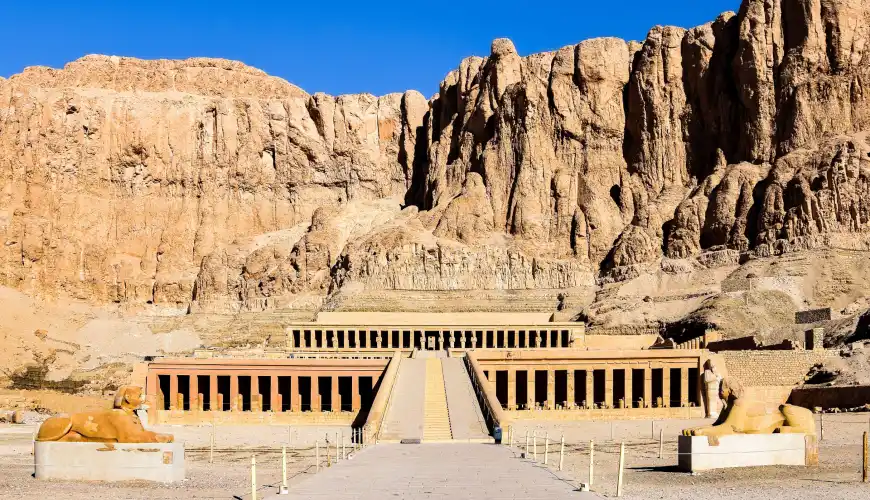Welcome, fellow adventurers! Gather around as we embark on a journey to unravel the ancient enigmas shrouding the illustrious Mortuary Temple of Hatshepsut. Brace yourselves for tales of mystery, grandeur, and perhaps a few wandering mummies.
Now, you may be wondering, what on earth is the Mortuary Temple of Hatshepsut? Ah, fear not, my curious companions! This incredible monument stands as a testament to the power and ambition of Queen Hatshepsut, an Egyptian pharaoh like no other.
Table of Contents
Picture this: a majestic temple nestled in the heart of Egypt, adorned with awe-inspiring statues, intricate carvings, and the whispers of a bygone era. It's a place where history comes alive, where secrets are whispered in hushed tones, and where Instagram-worthy moments await your eager lens (just remember, no flash photography—mummies despise it!).
Now, let us delve into the historical significance of this stunning architectural marvel. The Mortuary Temple of Hatshepsut serves as a memorial to the divine ruler herself, crafted with care and precision to honor her legacy. It stands as a testament to her unique reign and unwavering determination to leave her mark on the annals of Egypt's renowned history. Don't worry—no curses have been reported in recent times. Well, maybe just the occasional mosquito bite if you forget your bug repellent. Happy exploring!
So, dear adventurers, if you seek an adventure filled with ancient wonders, captivating stories, and the chance to impress your friends back home with your newfound knowledge of the Mortuary Temple of Hatshepsut, join us on our quest. Together, we shall unearth the past and be forever captivated by the essence of this extraordinary landmark.
History and Significance

Hatshepsut, the remarkable female Pharaoh who defied the norms of her time, left an indelible mark on Ancient Egyptian history. Ascending to the throne in the 15th century BCE, she not only broke gender barriers but also initiated a period of prosperity and cultural advancement. As the only female Pharaoh to rule ancient Egypt in her own right, Hatshepsut's reign stands as a testament to her leadership and resilience.
the purpose and importance of mortuary temples in Ancient Egyptian culture
In the grand tapestry of Ancient Egyptian culture, mortuary temples held a significant role. These temples served as the final resting places for the pharaohs and played a crucial part in their eternal afterlife. Constructed to honor and perpetuate the memory of the deceased rulers, these impressive structures were intended to facilitate the pharaoh's journey to the realm of the gods.
Among the many mortuary temples in Ancient Egypt, the Mortuary Temple of Hatshepsut stands out as an architectural marvel. Nestled against the backdrop of the Theban cliffs on the west bank of the Nile, this temple complex is a remarkable testament to the ingenuity and artistic prowess of the ancient Egyptians. It blends seamlessly into the natural landscape, with its terraces rising majestically and commanding a panoramic view of the surrounding area.
The Mortuary Temple of Hatshepsut boasts unique features that set it apart from other temples of its time. Its design revolved around the concept of divine birth, with the temple's structure resembling a series of colonnaded terraces leading to a central sanctuary. The complex is adorned with intricate wall reliefs depicting scenes from Hatshepsut's life and achievements, providing valuable insight into the politics, religion, and culture of the era. Additionally, the temple's grand sanctuaries and chapels were dedicated to the deities Amun, Anubis, and Hathor, emphasizing Hatshepsut's devotion to the gods and her divine legitimacy as Pharaoh.
The Mortuary Temple of Hatshepsut serves as a symbol of the historical and cultural significance of Hatshepsut's reign. Its unique architectural design and well-preserved reliefs enable us to explore the complexities of ancient Egyptian civilization and gain a deeper understanding of its rulers' beliefs and aspirations. As we unravel the secrets of this magnificent structure, we delve into a fascinating era where gender boundaries were challenged, and monumental works of art and architecture left an enduring legacy for generations to come.
what's in it for kids?
The Mortuary Temple of Queen Hatshepsut is not just a historic site; it is a captivating destination that can truly inspire and educate young minds. As one of the most renowned pharaohs in ancient Egypt, Queen Hatshepsut's temple offers a unique opportunity for families to delve into the fascinating world of ancient Egyptian civilization. From the colossal statues guarding the entrance to the intricately carved reliefs depicting the queen's reign, children will be enthralled by the grandeur and artistic mastery of this architectural wonder. Exploring the temple's corridors and discovering the secrets of its history will surely ignite their imaginations and instill a sense of wonder as they connect with the past and embark on their own archaeological adventure.
Design and Architecture
The Mortuary Temple of Hatshepsut stands as a majestic testament to ancient Egyptian design and architectural ingenuity. This awe-inspiring temple is comprised of three distinct levels that harmoniously blend with the natural terrain of the site.
Starting from the base, the first level consists of a grand colonnade with towering stone pillars that create a sense of grandeur and provide structural support. Moving upwards, the second level is adorned with terraces that offer breathtaking panoramic views of the surrounding landscape. These terraces not only serve as practical elements but are also infused with symbolic meaning, representing the transition between life and the afterlife.
One of the most captivating features of the Mortuary Temple of Hatshepsut is its intricate carvings and reliefs that adorn the walls and pillars. These depict scenes from Hatshepsut's life, her interactions with gods and goddesses, and her accomplishments as a ruler. The reliefs serve both a decorative and informative purpose, providing a glimpse into the political and religious beliefs of ancient Egypt. The delicate details and precise craftsmanship of these carvings bring the temple to life, transporting visitors back in time to the era of Hatshepsut's reign.
The colonnades and terraces not only showcase the mastery of Egyptian construction techniques but also emphasize the importance of creating a monumental structure that would serve as a lasting memorial for Hatshepsut's reign. The carvings and reliefs exemplify the intricate artistry employed by ancient Egyptian craftsmen, embodying the spiritual and cultural significance of the temple. As visitors explore the Mortuary Temple of Hatshepsut, they are awestruck by the harmonious blend of design elements and the profound symbolism embedded within its architectural features.
Excavations and Restoration
The Mortuary Temple of Hatshepsut has attracted the attention of historians, archaeologists, and restoration experts for centuries. Excavations and restoration efforts have played a crucial role in uncovering the temple's hidden secrets and preserving its remarkable historical significance.
Excavations of the temple began in the early 19th century with explorers such as Jean-François Champollion and Howard Carter. These early discoveries laid the foundation for subsequent research and restoration work. Over the years, numerous artifacts, such as statues, jewelry, and ancient writings, have been unearthed, shedding light on the life and reign of Hatshepsut.
One of the most notable discoveries at the Mortuary Temple of Hatshepsut was the finding of the temple's foundation deposits. These deposits contained offerings, tools, and inscriptions dating back to the time of construction, providing valuable insights into the temple's religious and ceremonial significance.
However, the restoration process has not been without its challenges. The temple suffered significant damage over the years due to natural elements, erosions, and even deliberate destruction in ancient times. The painstaking restoration work has involved meticulous cleaning, repairing, and reconstructing various elements of the temple, including the damaged colonnades, terraces, and intricate carvings. Restorers have employed advanced techniques to ensure the structural integrity of the temple while preserving its original aesthetic and cultural value.
Recent developments and ongoing research continue to expand our understanding of the Mortuary Temple of Hatshepsut. Archaeologists and scholars are constantly uncovering new fragments of ancient texts, enabling them to piece together the temple's history and decode its symbolism. Technological advancements, such as 3D scanning and virtual reality, have also facilitated virtual reconstructions and interactive experiences, allowing visitors to explore the temple as it once stood.
The continuous efforts in excavation, restoration, and research are crucial in preserving this architectural marvel and its historical significance for future generations. As more secrets are unveiled and new insights are gained, the Mortuary Temple of Hatshepsut continues to captivate and inspire visitors from around the world.
Visiting the Mortuary Temple of Hatshepsut
Planning a visit to the Mortuary Temple of Hatshepsut? You're in for an incredible journey into ancient Egyptian history and architecture. In this section, we'll provide you with practical information, tips, and key points of interest to make the most of your visit and capture unforgettable memories.
Practical Information:
- Location: The Mortuary Temple of Hatshepsut is located on the west bank of the Nile River in Luxor, Egypt. It stands proudly within the Deir el-Bahari complex
- Opening Hours: The temple opens daily from 6 am to 5 pm.
- Ticket Prices: As of 2023, ticket prices for the Mortuary Temple of Hatshepsut are 240 L.E.
Visitor Experience and Key Points of Interest:
- Breathtaking Architecture: As you approach the temple, you'll be awestruck by its grandeur and unique design. The temple features three terraced levels, connected by impressive colonnades and ramps. Take your time to explore each level and marvel at the intricate carvings and reliefs that adorn the walls.
- Sacred Spaces: The temple houses various sanctuaries and chapels, each with its own significance and purpose. Make sure to visit the birth colonnade, showcasing scenes depicting Hatshepsut's divine birth, and the lower courtyard, where you can admire the iconic Osirian statues.
- The Chapelle Rouge: This is a separate chapel within the temple complex and is believed to hold the remains of Queen Hatshepsut. It is a must-visit spot for history enthusiasts and those interested in the queen's legacy.
Tips for an Enriching Visit:
- Timing: Arrive early to avoid crowds and make the most of your visit. The early morning light adds a magical touch to the temple's beauty, making it perfect for photography.
- Guided Tours: Consider joining a guided tour led by expert Egyptologists. They can provide fascinating insights into the history and symbolism of the temple, enhancing your overall experience.
- Respectful Behavior: Remember to respect the historical significance of the site. Refrain from touching or climbing on the ancient structures and be mindful of the temple's sacred nature.
By following these tips and immersing yourself in the majestic atmosphere of the Mortuary Temple of Hatshepsut, you're sure to have an unforgettable visit. Capture those special moments and create lasting memories as you delve into the rich history of one of Egypt's most remarkable ancient monuments.
Overall, the Mortuary Temple of Hatshepsut stands as a testament to the remarkable achievements of one of ancient Egypt's most influential leaders. Its grandeur, architectural marvels, and intricate reliefs provide a captivating glimpse into the past. As you explore this magnificent temple, you'll uncover the secrets of Hatshepsut's reign and gain a deeper understanding of ancient Egyptian culture. So, embark on this extraordinary journey, immerse yourself in history, and let the Mortuary Temple of Hatshepsut leave an indelible mark on your memory. Happy travels and may the spirit of Hatshepsut guide your way!






